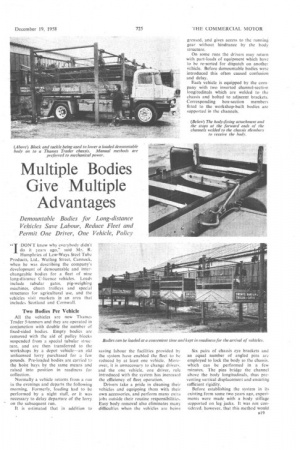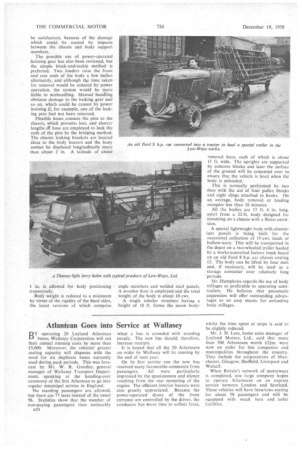Multiple Bodies Give Multiple Advantages
Page 53

Page 54

If you've noticed an error in this article please click here to report it so we can fix it.
Demountable Bodies for Long-distance Vehicles Save Labour, Reduce Fleet and Permit One Driver, One Vehicle, Policy
i
,6•DON'' know why everybody didn't
• do it years ago,'.' said Mr: R.
Humphries of Lew-Ways Steel Tube Products, Ltd., Watling Street, Cannock, when he was describing the company's development of demountable and interchangeable bodies for a fleet of nine long-distance C-licence vehicles. Loads include tubular gates, pig-weighing machines, churn trolleys and special structures for agricultural use, and the vehicles visit markets in an area that includes Scotland and Cornwall.
Two Bodies Per Vehicle
All the vehicles are new Thames Trader 5-tonners and they are operated in conjunction with double the number of fixed-sided bodies. Empty bodies arc removed with the aid of pulley blocks suspended from a special tubular structure, and are then transferred to the workshops by a depot vehicle—an old unlicenSed lorry purchased for a few pounds. Pre-loaded bodies are carried to the hoist bays by the same means and raised into position in readiness for collection.
Normally a vehicle returns from a run in the evenings and departs the following morning. Formerly, loading had to be performed by a night staff, or it was necessary to delay departure of the lorry 011 the subsequent run.
It is estimated that in addition to
saving labour the facilities provided by the system have enabled the fleet to be I-el:liked by at least one vehicle. Moreover, it is unnecessary to change drivers, and the one vehicle, one driver, rule introduced with the system has increased the efficiency of fleet operation.
Drivers take a pride in cleaning their vehicles and equipping them with their own accessories, and perform many extra jobs outside their routine responsibilities. Easy body removal also eliminates many difficulties when the vehicles are beim! greased, and gives access to the running gear without hindrance by the body structure.
On some runs the drivers may return with part-loads of equipment which have to be re-sorted for dispatch on another Vehicle. Before demountable bodies were introduced this often caused confusion and delay.
Each vehicle is equipped by the company with two inverted channel-section longitudinals which are welded to the chassis and bolted to adjacent brackets. Corresponding box-section members fitted to the workshop-built bodies are supported in the channels. . (Be/ow) The body-fixing attachment and the stops at the forward ends of the channels welded to the chassis ttlembers to receive the hotly.
Six pairs of chassis eye brackets and an equal number of angled pins are employed to lock the body to the chassis, which can be performed in a few minutes. The pins bridge the channel above the body longitudinals, thus meventing vertical displacement and ensuring sufficient rigidity.
Before establishing the system in its existing form some two years ago, experiments were made with a body stillage supported on leg jacks. It was not considered, however, that this method would be satisfactory, because of the damage which could be caused by impacts between the• chassis and body support members.
The possible use of power-operated hoisting gear has also been reviewed, but the simple block-and-tackle method is preferred. Two loaders raise the front and rear ends of the body a few inches alternately, and although tip time taken for removal would be reduced by power operation, the system would be more liable to mishandling. Manual handling obviates damage to the locking gear and so on, Which could be caused by power hoisting if,. for example, one of the locking pins had not been removed.
Flexible hoses connect the pins to the chassis, which prevents loss, and shorter lengths oT hose are employed to lock the ends of the pins by the bridging method. The chassis locking brackets are located close to the body bearers and the body cannot be displaced longitudinally more than about 2 in. A latitude of about
1 in. is allowed for body positioning transversely:
Body weight is reduced to a minimum by virtue of the rigidity of the fixed sides, the latest versions of which comprise angle members and welded steel panels. A wooden floor is employed and the total weight of the body is about 10 cwt.
A single tubular structure having a height of 10 ft. forms the seven body
removal bays, each of which is about 11 ft. wide. The uprights are supported by concrete blocks and later the surface of the ground will be cemented over to ensure that the vehicle is level when the body is unloaded.
This is normally performed by two men with the aid of fcrur pulley blocks and eight slings. attached to hooks. On an average, body removal or loading occupies less than 10 Minutes.
All the bodies are 17 ft. 6 in. long. apart from a 22-ft, body designed for mounting on a chassis with a Baico extension.
A special lightweight body with aluminium panels is being built for the occasional collection of 15-cwt. loads of hollow-ware. This will be transported in the depot on a two-wheeled trailer hauled by a works-converted factory truck based on an old Ford 8 h.p. car chassis costing .43. The body can be lifted by four men and, ifnecessary, will be used as a storage container over relatively long 'periods.
Mr. Humphries regards the use of body stillages as preferable to operating semitrailers. He believes that pneumatic suspension will offer outstanding advantages as an easy means for unloading body. stillages.




































































































